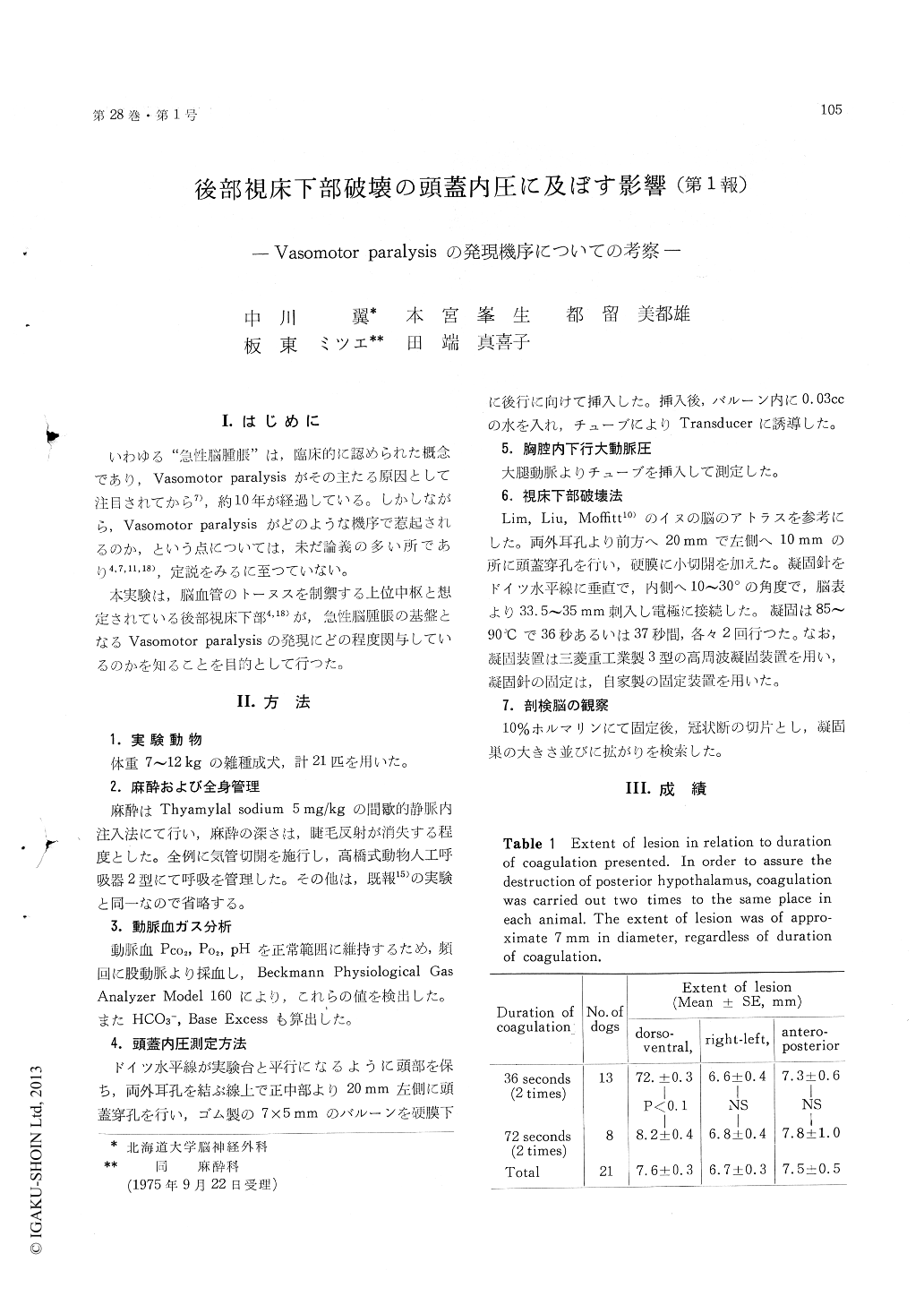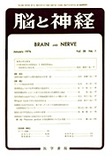Japanese
English
- 有料閲覧
- Abstract 文献概要
- 1ページ目 Look Inside
I.はじめに
いわゆる"急性脳腫脹"は,臨床的に認められた概念であり,Vasomotor paralysisがその主たる原因として注目されてから7),約10年が経過している。しかしながら,Vasomotor paralysisがどのような機序で惹起されるのか,という点については,未だ論義の多い所であり4,7,11,18),定説をみるに至つていない。
本実験は,脳血管のトーヌスを制禦する上位中枢と想定されている後部視床下部4,18)が,急性脳腫脹の基盤となるVasomotor paralysisの発現にどの程度関与しているのかを知ることを目的として行つた。
Since the Langfitt et al's report in 1965, vaso-motor paralysis has been understood as the maincause leading acute brain swelling.
However, the definate mechanism inducing vaso-motor paralysis is still remaining obscure.
This experiment was designed to clarify whetheror not the dysfunction of posterior hypothalamusplays a specific role in the development of vaso-motor paralysis.
(1) METHODS:
Using adult mongrel dogs, which was anesthetizedwith intravenous injection of thyamylal sodiumwith controlled ventilation, coagulation needle wasstereotaxically inserted toward either unilateral orbilateral posterior hypothalamus, which was sub-sequently destroyed with the coagulator. In orderto assure the destruction of posterior hypothalamus,coagulation was carried out two times in eachanimal.
In regard to duration of coagulation, either 36or 72 seconds was selected.
Arterial Po2, Pco2 and pH were maintained in the normal range by frequent determinations of blood samples.
The intracranial pressure (ICP) was continously monitored through a small balloon inserted inside the dura mater.
Before and after each procedure to the hypo-thalamus, the systemic arterial pressure (SAP) waselevated by intravenous injection of norepinephrine(5×10-3mg/kg) in order to investigate whether ornot the ICP increases in accordance with elevationof SAP.
The exact coagulated sites of hypothalamus wereconfirmed through investigation of coronal sectionafter fixation of brain.
(2) RESULTS:
The extent of lesion was of approximate 7mmin diameter, regardless of duration of coagulation(Table 1).
The examples of both unilateral and bilateralcoagulations of posterior hypothalamus are demon-strated in Fig. 1 and 2, respectively.
The summary of coagulated sites of hypothalamusin 21 dogs is presented in Fig. 3. The nuclei ofhypothalamus posterior and hypothalamus dorso-medialis, which, we think, correspond to "posteriorhypothalamus" was coagulated unilaterally or bi-laterally in all of 21 dogs.
The oscillographic recording in Fig. 4, indicatesthat the ICP increases slightly and temporarilyafter insertion of coagulation needle, or first andsecond coagulations, while the SAP decreases slight-ly to moderately but temporarily after each pro-cedure.
The degree of elevation was only 45.0±8.4mm H2O even after first coagulation, although the ICPafter each procedure was significantly elevated(Fig. 5).
The response of ICP to intravenous injection ofnorepinephrine is demonstrated in Fig. 6, whichindicates that the elevation of ICP after each pro-cedure is very slight in degree against the markedelevation of SAP. The ICP/MAP ratio of elevationby intravenous injection of norepinephrine is sum-marized in Fig. 7, which reveals that the ICP/MAPratio of elevation was not obviously significant(NS) after each procedure, compared with in control.
(3) CONCLUSIONS:
The authors think that the dysfunction of pos-terior hypothalamus doesn't play a specific role inthe development of vasomotor paralysis leadingacute brain swelling, under the circumstances thatthe ICP and the arterial Pco2, Po2 and pH aremaintained in the normal range.

Copyright © 1976, Igaku-Shoin Ltd. All rights reserved.


